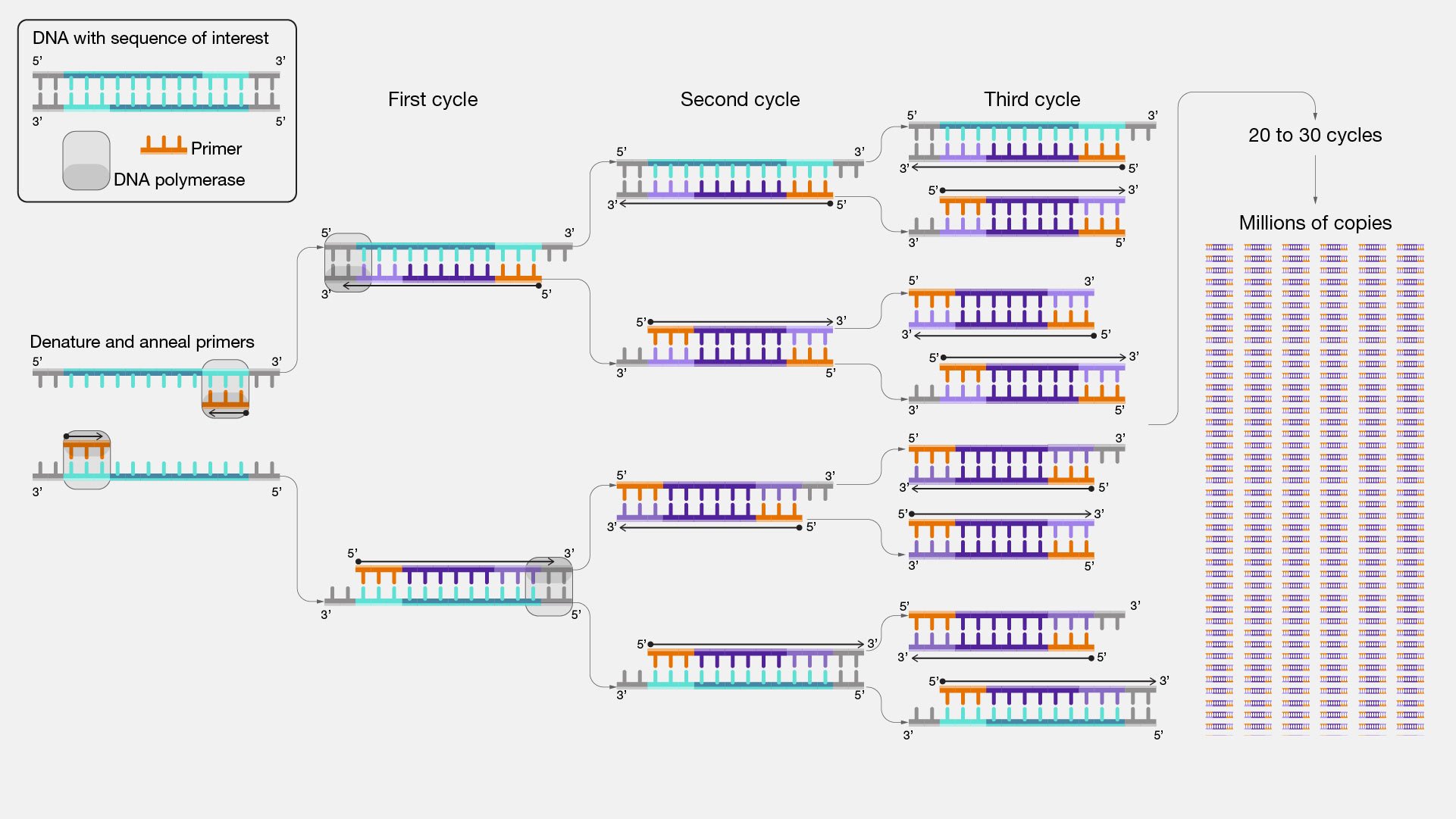
Factually inaccurate: PCR-based COVID-19 tests don’t contain genetic DNA sequences. In particular, it doesn't have genetic information coding for the green fluorescent protein. Furthermore, the protein doesn’t even come from insects, but from jellyfish, contrary to what was claimed.

FULL CLAIM: “PCR kits have never been about testing for COVID” [...] They’re cloning devices”; they “genetically modify humans” and because of that “people are becoming part insects”
REVIEW
The COVID-19 pandemic brought new scientific concepts to the public’s attention, such as mRNA or the polymerase chain reaction (PCR). While it’s a good opportunity to popularize science, misunderstanding of these concepts can help spread disinformation.
One example is the claim that PCR-based COVID-19 detection kits are cloning devices aimed at mutating humans. Ariyana Love, who self-identifies as a naturopath, made a series of inaccurate claims regarding PCR-based COVID-19 detection kits during an interview with Stew Peters. Peters is a podcaster who has previously propagated disinformation about COVID-19 and COVID-19 vaccines. We’ll show below why Love’s claims are contradicted by elementary biological science and reflect a profound misunderstanding of molecular biology technologies.
Claim 1 (Inaccurate): COVID-19 detection kits are in fact cloning devices
Love claimed that “PCR kits have never been about testing for COVID […] They’re cloning devices”. To support her claim, Love cited a study from 2015 by Hoseini and Sauer titled “Molecular cloning using polymerase chain reaction, an educational guide for cellular engineering”[1]. Love’s reasoning is that the article described the use of PCR to perform molecular cloning. Given that COVID-19 detection kits used on humans also rely on PCR, she concluded that the kits must be human cloning devices.
This is inaccurate. Love seems to be unaware of the difference between reproductive cloning and molecular cloning. Cloning refers to the creation of a genetically identical copy of something. The replication of a viable entire organism is called reproductive cloning, like in the case of Dolly the sheep in 1996. This is what Love and Peters are referring to when they talk about “human cloning technology”.
However, the study by Hoseini and Sauer refers to molecular cloning, which is the duplication of a genetic sequence in a laboratory test tube. This has been common practice for decades in every molecular biology lab in the world and has nothing to do with cloning entire organisms. The study doesn’t address reproductive cloning in any way and therefore isn’t supporting evidence for Love’s claim.
The reason why both the Hoseini and Sauer study and COVID-19 detection kits use PCR is because PCR is a powerful technique that allows us to produce many identical copies of an initially small amount of genetic material (Figure 1).

Figure 1. An overview of how PCR works. The starting material is a double-stranded DNA sequence. In the first cycle of the reaction, this double-stranded DNA separates into two strands (denaturation step). Then, short DNA sequences called primers (in orange) bind at specific places of the separated strands (annealing step). The design of primers dictates where they can bind on the DNA strand. Primers flank the region of interest that will be amplified (shown in light blue). A protein called DNA polymerase then synthesizes a new DNA strand (in purple) using the initial DNA strand as a template (elongation step). The end of the cycle yields two identical double-stranded DNA sequences, thus achieving molecular cloning. The cycle is then repeated, doubling the amount of DNA each time (source).
In the case of the Hoseini and Sauer studies, they used it to amplify a specific gene of interest in vitro. In the case of PCR-based COVID-19 detection kits, it is used to detect the presence of small amounts of SARS-CoV-2 genetic material in the fluids of infected people.
Claim 2 (Inaccurate): COVID-19 detection kits make human/insect hybrids by inserting insect genes in our genome
Love then claimed that the kits are used to “genetically modify humans” by inserting genetic information from the kit into the genome. Specifically, she said that the kits contain “green fluorescent protein, which comes from the firefly”, meaning that “people are becoming part-insects”. But this claim is also inaccurate and Love made multiple mistakes in the scientific facts she quoted.
First, COVID-19 detection kits don’t contain gene mRNA or DNA sequences. The contents of several kits are available on the U.S. Food and Drug Administration website. The kits contain the ingredients required for a PCR, which doesn’t include genes.
As shown in Figure 1, the PCR reaction requires a DNA sequence to act as a template. In the case of PCR-based COVID-19 tests, this DNA sequence actually comes from the person. The operator uses a swab to collect biological samples from the person being tested, usually in the mouth or in the nose. This sample contains genetic material from the person itself and, possibly, from SARS-CoV-2. Then, the PCR is performed in a test tube on this sample. Performing the test thus doesn’t insert genes from other species into the body.
Second, green fluorescent protein (GFP) doesn’t come from the firefly, contrary to what Love claimed, but from the jellyfish Aequorea victoria. So GFP has nothing to do with insects. It’s likely that Love confused GFP with luciferase, which indeed comes from the firefly. Luciferase is a bioluminescent protein—not a fluorescent protein contrary to what Love stated—often used in biochemical assays. Some people had claimed that COVID-19 vaccines contained luciferase, which is also inaccurate, as Health Feedback explained.
To support her claim, Love cited two studies. The first is a study from researchers at Lünd University in Sweden[2], alleging that their research showed that mRNA from COVID-19 vaccines could be converted into DNA and inserted into the human genome. It’s not the first time this claim about the study was made; Health Feedback explained in a previous review that this interpretation of the study was erroneous and that the Lünd university study didn’t show that. Besides, Love’s point is moot because, as explained earlier, PCR COVID-19 detection kits don’t contain mRNA or DNA sequences.
The second study by Wood et al. describes the use of molecular tools to modify the genome of the microscopic worm Caenorhabditis elegans[3], often used as a model organism for studying human development and diseases. Biology labs around the world commonly perform genetic modification of lab animals such as C. elegans, fruit flies or mice. However, this doesn’t imply that the same is being done to humans. Furthermore, the study by Wood et al. is unrelated to PCR-based detection kits and so isn’t supporting evidence for Love’s claim.
Claim 3 (Inaccurate): The NIH admitted that PCR-based detection tests are cloning and genome-modifying devices
Throughout the interview, Love insisted that the U.S. National Institutes of Health (NIH) already was aware of the alleged use of PCR-based COVID-19 kits as cloning devices because the work by Hoseini et al. and Wood et al. was published on the NIH website. In fact, Love is confusing the NIH website with the scientific literature repository PubMed. PubMed is a database hosted by the NIH National Library of Medicine—hence the presence of the NIH logo on PubMed—but contains millions of scientific publications from many publishers, even when the research team or the publisher are unrelated to the NIH.
In this case, the study by Hoseini et al. is from a research team in Germany and was published in the Journal of Biological Engineering, from the Springer Nature private publishing group. The study by Wood et al. was published in the journal Science, which is published by the American Association for the Advancement of Science. While Wood’s research was funded by a NIH grant, this is not the same as saying that his paper was a NIH study.
Conclusion
In conclusion, PCR-based COVID-19 detection kits aren’t cloning devices and don’t modify the human genome. PCR is a widely used technique for molecular cloning, meaning the replication of genetic sequences in a test tube. Although it shares a common word, it’s different from reproductive cloning of entire organisms. PCR tests don’t modify the human genome, and all the alleged supporting evidence cited by Love in her interview are actually unrelated to PCR tests.
REFERENCES
- 1 – Hoseini & Sauer (2015) Molecular cloning using polymerase chain reaction, an educational guide for cellular engineering. Journal of Biological Engineering.
- 2 – Alden et al. (2022) Intracellular Reverse Transcription of Pfizer BioNTech COVID-19 mRNA Vaccine BNT162b2 In Vitro in Human Liver Cell Line. Current Issues in Molecular Biology.
- 3 – Wood et al. (2011) Targeted genome editing across species using ZFNs and TALENs. Science.


